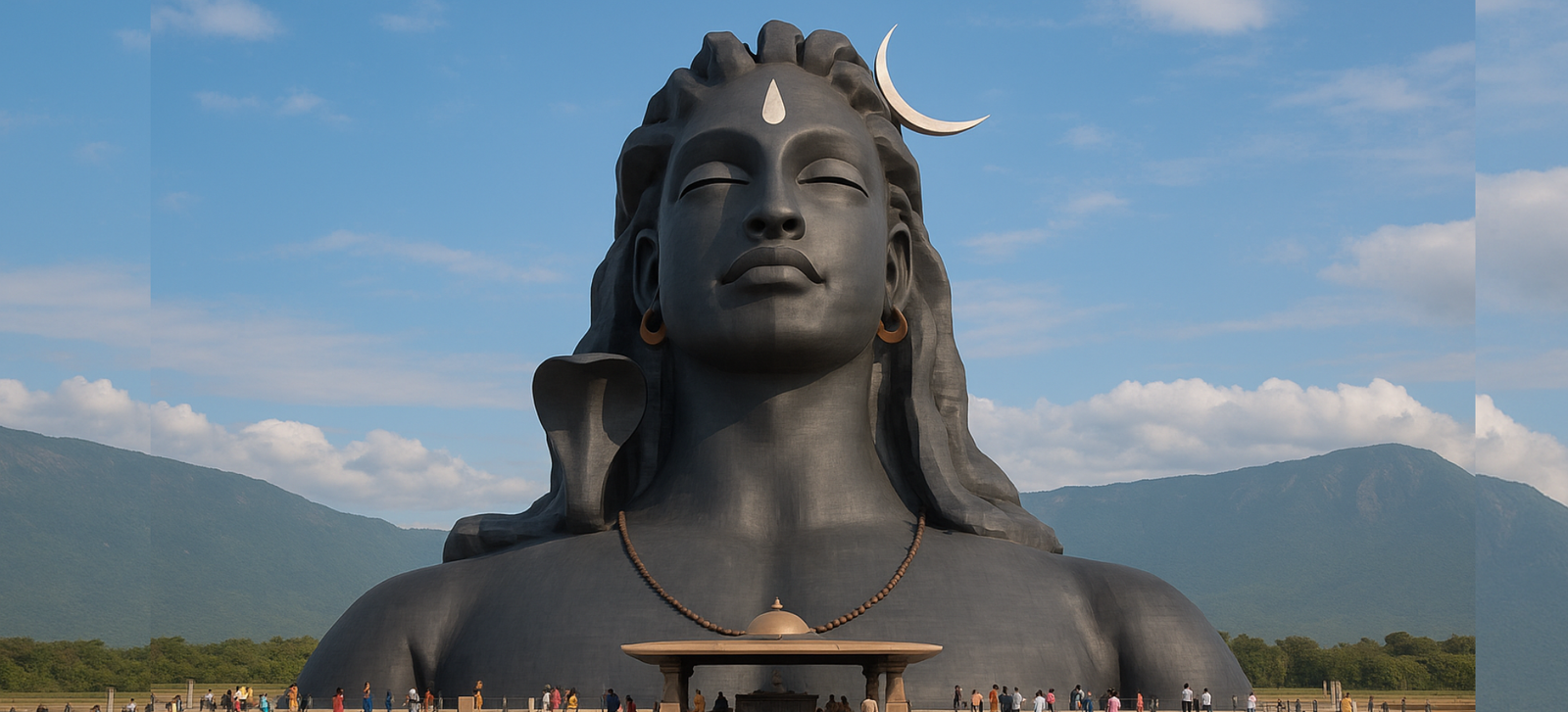A brutally honest, humorous account of a first-timer’s journey through Inner Engineering at Isha Foundation—complete with pre-dawn wake-ups, ice baths, and unexpected moments of profound stillness.
Starting a spiritual journey sounds like something people do in Instagram posts with perfect lighting and designer yoga mats. The reality? You’re usually the one fumbling with basic poses at 5:30 AM, wondering if enlightenment necessarily requires this much physical discomfort.
The YouTube Rabbit Hole That Changed Everything
It started innocently enough—a late-night YouTube session that somehow led me from cat videos to a bearded mystic with twinkling eyes. Sadhguru had this uncanny ability to deliver profound wisdom while looking like he’d just shared an inside joke with the universe. His blend of ancient wisdom and playful irreverence was magnetic.
After three videos, I was hooked. After ten, I was researching Inner Engineering programs. After twenty, I was booking my ticket to the Isha Yoga Center, despite having zero meditation experience and the flexibility of a wooden plank.
First Impressions: Welcome to Spiritual Boot Camp
The Isha Yoga Center sits at the base of the Velliangiri Mountains like a serene sanctuary that Instagram dreams are made of. Walking onto the campus, I was hit by two things simultaneously: a profound sense of peace, and the panic-inducing realization that I’d forgotten to pack deodorant for a week-long retreat.
The volunteers greeted me with smiles so genuinely peaceful, I briefly wondered if they were part of some elaborate wellness cult. They handed me my accommodation assignment—”Nadhi Cottage”—which sounded quaint until I learned it came with a 5:30 AM wake-up call and a roommate who snored like a congested elephant seal.
Reality Check: Simple Living, Complex Adjustments
My room was a masterclass in minimalism: one bed, one bucket, one mirror, and approximately 47 opportunities per day to confront my own thoughts without the usual distractions of Netflix or social media.
The daily schedule was posted like a military operation:
- 5:30 AM: Wake up (optional coffee crying session)
- 6:00 AM: Morning practices
- 7:30 AM: Breakfast (surprisingly good)
- 9:00 AM: Program sessions
- And so on, until evening…
I set four alarms. My phone judged me silently. But somehow, miraculously, I showed up—disheveled and questioning my life choices, but present.
The Devi’s First Impression
On my second evening, during the full moon, I wandered into the Linga Bhairavi Temple. Nothing could have prepared me for the sensory overload: the thick fragrance of jasmine and sandalwood, the hypnotic chanting that seemed to vibrate through the marble floors, and the Devi’s eyes—fierce, compassionate, and somehow seeing right through every excuse I’d ever made.
For the first time in years, my perpetually chattering mind fell completely silent. Not meditation-app silent, but genuinely, profoundly quiet. Either the Devi had special powers, or I’d finally reached peak mental exhaustion. Either way, I wasn’t complaining.
The Sadhguru Hope (and Gentle Letdown)
I’d harbored secret fantasies of randomly encountering Sadhguru—maybe sharing a knowing nod over breakfast, or getting profound life advice while waiting in line for the bathroom. When I casually asked a volunteer about the possibility, she smiled with the patience of someone who’d answered this question roughly 10,000 times before.
“He’s traveling this month,” she said gently.
My heart sank slightly, but my wallet was relieved. Apparently, spiritual growth doesn’t come with celebrity meet-and-greets.
Dhyanalinga: Where Silence Gets Serious
The Dhyanalinga isn’t just quiet—it’s otherworldly quiet. Signs everywhere reminded us: no talking, no phones, no fidgeting, no eye contact. You enter with your usual mental circus and somehow leave feeling like someone had performed surgery on your anxiety.
I sat there for what felt like hours (probably 20 minutes), and for once, even my stomach—typically the loudest critic in any quiet space—cooperated completely. The silence wasn’t empty; it was full of something I couldn’t name but definitely wanted more of.
Surya Kund: The Ice Bath That Humbled Me
If Dhyanalinga was gentle transformation, Surya Kund was spiritual shock therapy. This sacred underground pool was approximately the temperature of melted glaciers, and apparently, taking a dip was “highly recommended.”
I approached the water like someone about to defuse a bomb. The first step in was breathtaking—literally. By the time I was waist-deep, I was making sounds I didn’t know humans could produce. But after thirty seconds of full-body shivering, something shifted. Maybe it was endorphins. Maybe it was surrender. Maybe it was hypothermia.
I emerged feeling strangely victorious and slightly superhuman.
Inner Engineering: Where the Real Work Begins
The actual program was a carefully orchestrated dance between ancient practices and modern sensibilities. Our instructor possessed the kind of steady presence that made you want to sit straighter and breathe deeper just by proximity.
We started with preparatory practices—gentle movements that revealed exactly how disconnected I’d become from my own body. Simple stretches became negotiations with muscles I’d apparently been ignoring for years.
But somewhere between the breathing exercises and basic postures, something began to shift. My mind, usually racing between seventeen different worries, started to slow down. My chronic internal monologue dialed down from shouting to conversational volume.
Sadhguru on Screen: Presence Without Physical Presence
While Sadhguru wasn’t there in person, his video sessions were surprisingly powerful. He spoke about taking charge of your inner experience, about joy being your natural state, and about how most human suffering comes from taking yourself too seriously.
One particular line stayed with me: “The quality of your life is determined by how well you manage your inner situation, not your external circumstances.”
I initially rolled my eyes. Then I paused. Then I realized he might actually be onto something.
The Shambhavi Moment: 21 Minutes That Changed Everything
The program culminated with the initiation into Shambhavi Mahamudra—a 21-minute practice combining breathing, postures, and focused attention. It sounds deceptively simple until you’re actually doing it in a room full of people who seem to know something you don’t.
During that first guided session, something clicked. Not fireworks or mystical visions, but a profound sense of coming home to myself. For 21 minutes, I wasn’t worried about work, relationships, or whether I was doing it “right.” I was just… present.
Then came the commitment: practicing this twice daily for 40 days minimum. My inner rebel immediately started planning excuses. My inner seeker, surprisingly, said, “Let’s try.”
The Transformation (Or: What Actually Changed)
Leaving the program, I took inventory. No magical overnight personality transplant. No sudden ability to levitate or read minds. But something had definitely shifted.
My shoulders, chronically tensed from years of stress, had dropped about two inches. My breathing had become deeper, more natural. Most notably, my relationship with my own thoughts had changed. Instead of being yanked around by every worry or random mental tangent, I’d developed a small but significant gap—a pause between stimulus and reaction.
The real test came in the weeks following. Twice daily, I rolled out my yoga mat and practiced Shambhavi. Some days felt transcendent. Others felt like elaborate procrastination from real life. But consistently, gradually, I noticed changes: sleeping better, reacting less, enjoying simple moments more.
The Honest Assessment: Was It Worth It?
Six months later, do I float through life in a state of perpetual bliss? Hardly. I still get stuck in traffic and feel annoyed. I still procrastinate and worry about things beyond my control. But now there’s a quality of awareness underneath it all—a sense that I have choices about how I respond to life rather than just being dragged along by circumstances.
The practices didn’t make me perfect; they made me more conscious. And that, it turns out, makes all the difference.
Would I recommend it? Absolutely, especially if you’re curious about meditation but intimidated by the seemingly perfect people in yoga studios. This program is designed for normal humans with messy lives and overactive minds.
Would I go back? Already planning my next visit—this time with proper toiletries and realistic expectations about enlightenment timelines.
Until then, it’s me, my daily practice, and a growing appreciation for the profound ordinariness of being fully awake to life as it actually is.


Leave a Reply